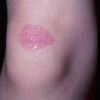Inherited epidermolysis bullosa
- PMID: 20507631
- PMCID: PMC2892432
- DOI: 10.1186/1750-1172-5-12
Inherited epidermolysis bullosa
Abstract
Inherited epidermolysis bullosa (EB) encompasses a number of disorders characterized by recurrent blister formation as the result of structural fragility within the skin and selected other tissues. All types and subtypes of EB are rare; the overall incidence and prevalence of the disease within the United States is approximately 19 per one million live births and 8 per one million population, respectively. Clinical manifestations range widely, from localized blistering of the hands and feet to generalized blistering of the skin and oral cavity, and injury to many internal organs. Each EB subtype is known to arise from mutations within the genes encoding for several different proteins, each of which is intimately involved in the maintenance of keratinocyte structural stability or adhesion of the keratinocyte to the underlying dermis. EB is best diagnosed and subclassified by the collective findings obtained via detailed personal and family history, in concert with the results of immunofluorescence antigenic mapping, transmission electron microscopy, and in some cases, by DNA analysis. Optimal patient management requires a multidisciplinary approach, and revolves around the protection of susceptible tissues against trauma, use of sophisticated wound care dressings, aggressive nutritional support, and early medical or surgical interventions to correct whenever possible the extracutaneous complications. Prognosis varies considerably and is based on both EB subtype and the overall health of the patient.
Figures












References
-
- Fine JD, Bauer EA, Gedde-Dahl T. In: Inherited epidermolysis bullosa: definition and historical overview. Fine JD, Bauer EA, McGuire J, Moshell A, editor. Epidermolysis Bullosa: Clinical, Epidemiologic, and Laboratory Advances, and the Findings of the National Epidermolysis Bullosa Registry Baltimore: Johns Hopkins University Press; 1999. pp. 1–19.
-
- Fine JD, Hintner H, eds. Life with Epidermolysis Bullosa: Etiology, Diagnosis, and Multidisciplinary Care and Therapy. Wien New York: Springer Verlag GmbH; 2009. p. 338.
-
- Fine JD, Bauer EA, Briggaman RA. Revised clinical and laboratory criteria for subtypes of inherited epidermolysis bullosa: a consensus report by the Subcommittee on Diagnosis and Classification of the National Epidermolysis Bullosa Registry. J Amer Acad Dermatol. 1991;24:119–135. doi: 10.1016/0190-9622(91)70021-S. - DOI - PubMed
Publication types
MeSH terms
LinkOut - more resources
Full Text Sources
Other Literature Sources

